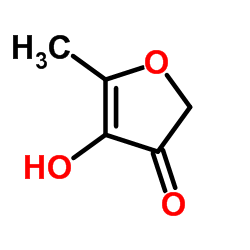4-hyroxy-5-methyl-3-furanone

4-hyroxy-5-methyl-3-furanone structure
|
Common Name | 4-hyroxy-5-methyl-3-furanone | ||
|---|---|---|---|---|
| CAS Number | 19322-27-1 | Molecular Weight | 114.099 | |
| Density | 1.4±0.1 g/cm3 | Boiling Point | 218.3±40.0 °C at 760 mmHg | |
| Molecular Formula | C5H6O3 | Melting Point | 129-133 °C(lit.) | |
| MSDS | Chinese USA | Flash Point | 97.5±20.8 °C | |
|
Norfuraneol dephosphorylates eNOS at threonine 495 and enhances eNOS activity in human endothelial cells.
Cardiovasc. Res. 81(4) , 750-7, (2009) Pentoses are widely abundant in organic food. Thermal treatment of pentoses leads to the formation of norfuraneol (NF). The aim of this study was to show whether NF, which is taken up regularly, for example with cooked food, affects the human endothelial nitr... |
|
|
Investigation of the reaction between 4-hydroxy-5-methyl-3(2H)-furanone and cysteine or hydrogen sulfide at pH 4.5.
J. Agric. Food Chem. 47(4) , 1626-34, (1999) Reaction of 4-hydroxy-5-methyl-3(2H)-furanone (HMF) with cysteine or hydrogen sulfide at pH 4.5 for 60 min at 140 degrees C produced complex mixtures of volatile compounds, the majority of which contained sulfur. Sixty-nine compounds were identified, some ten... |
|
|
Heterocyclic volatiles formed by heating cysteine or hydrogen sulfide with 4-hydroxy-5-methyl-3(2H)-furanone at pH 6.5.
J. Agric. Food Chem. 49(2) , 816-22, (2001) The reaction of 4-hydroxy-5-methyl-3(2H)-furanone (HMF) with cysteine or hydrogen sulfide at pH 6.5 for 60 min at 140 degrees C produced complex mixtures of volatile compounds, the majority of these containing either sulfur or nitrogen. Of the 68 compounds de... |
|
|
Maillard reaction products modulating the growth of human tumor cells in vitro.
Chem. Res. Toxicol. 16(1) , 48-55, (2003) We investigated the effect of a series of Maillard reaction products formed from carbohydrates under household heating conditions on the growth of human tumor cells in vitro. 4-Hydroxy-5-methyl-3-(2H)-furanone (1) was found to potently enhance the proliferati... |
|
|
LuxS: its role in central metabolism and the in vitro synthesis of 4-hydroxy-5-methyl-3(2H)-furanone.
Microbiology 148(Pt 4) , 909-22, (2002) Many bacteria produce extracellular molecules which function in cell-to-cell communication. One of these molecules, autoinducer 2 (AI-2), was first described as an extracellular signal produced by Vibrio harveyi to control luciferase expression. Subsequently,... |
|
|
An efficient flow-photochemical synthesis of 5H-furanones leads to an understanding of torquoselectivity in cyclobutenone rearrangements.
Angew. Chem. Int. Ed. Engl. 51(18) , 4405-8, (2012)
|
|
|
A dual mechanism of 4-hydroxy-5-methyl-3[2H]-furanone inhibiting cellular melanogenesis.
J. Cosmet. Sci. 59(2) , 117-25, (2008) In previous studies, 4-hydroxy-5-methyl-3[2H]-furanone (HMF) was shown to have potent antioxidative and antimelanogenic effects, suggesting its potential use as a depigmenting agent. The present study investigated its mechanism of action on murine melanoma B1... |
|
|
Reinvestigation of the reaction between 2-furancarboxaldehyde and 4-hydroxy-5-methyl-3(2H)-furanone.
J. Agric. Food Chem. 47(12) , 4962-9, (1999) The reaction between 2-furancarboxaldehyde and 4-hydroxy-5-methyl-3(2H)-furanone was reinvestigated as a part of a systematic study on low molecular weight colored compounds from the Maillard reaction. In acetic acid/piperidine, besides 2-(2-furanylmethylene)... |
|
|
Formation of 5-methyl-4-hydroxy-3[2H]-furanone in cytosolic extracts obtained from Zygosaccharomyces rouxii.
J. Agric. Food Chem. 51(5) , 1410-4, (2003) Formation of the flavor compound and precursor 4-hydroxy-5-methyl-3[2H]-furanone (HMF, norfuraneol) was demonstrated in cytosolic protein extracts obtained from Zygosaccharomyces rouxii after incubation with a number of carbohydrate phosphates. 4-Hydroxy-5-me... |
|
|
Chemometric applications of thermally produced compounds as time-temperature integrators in aseptic processing of particulate foods.
Adv. Exp. Med. Biol. 434 , 91-9, (1998) The chemometric principle was used to derive a guideline for obtaining a simple "yes or no" answer about the sterility of food particulates heated at aseptic processing temperatures. A quadratic temperature pulse model was used to estimate bacterial destructi... |